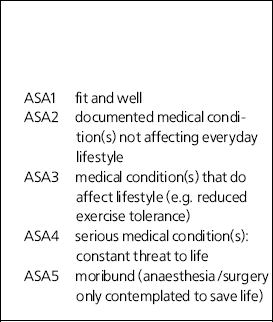These guidelines have been endorsed by the Royal College of Anaesthetists. The Royal College of Anaesthetists produces guidance on the safety of anaesthetic services in its publication Guidelines for the Provision of Anaesthetic Services, to which reference should be made. This document is available on the internet at http://www.rcoa.ac.uk/dload/GLINES. PDF. In the near future the Royal College of Psychiatrists and Royal College of Anaesthetists, in collaboration with the National Institute for Clinical Excellence, will produce fuller guidelines.
Staffing
-
• There must be a named consultant anaesthetist responsible for the electroconvulsive therapy (ECT) clinic. The consultant should have regular input, and not just be nominally in charge.
-
• A suitably experienced trainee or non-consultant career grade anaesthetist can administer the anaesthetics as long as he or she is supported by a named consultant who takes responsibility for the delegation. This would preferably be the consultant anaesthetist responsible for the clinic's management. Guidelines for the supervision of trainees can be found in the Royal College of Anaesthetists document, The CCST in Anaesthesia I: General Principles, a Manual for Trainees and Trainers (http://www.rcoa.ac.uk/dload.rcoa.ccst1.pdf).
-
• Continuity of care needs to be established, with a minimum number of people rotating through the service.
-
• A core group of suitably experienced anaesthetists is required.
-
• ECT sessions should be incorporated into job plans, and not be done routinely by the on-call anaesthetists, or occasional unsupervised senior house officer.
-
• All anaesthetists must have a suitably trained assistant present.
-
• The training and qualifications of anaesthesia assistants are detailed in The Anaesthesia Team (Association of Anaesthetists of Great Britain and Ireland, 1998).
-
• Continuity and experience are also important for assistants.
Remote siting of the ECT clinic
A remote site is defined as not having immediate access to critical care, namely cardiac arrest and intensive care teams. In the majority of cases, where there is no added risk, ECT should not prove any higher risk than minor day-case surgery, which is regularly practised at remote sites. However, the following guidelines should be adhered to:
-
• For any patient assessed as being ASA3 (see Box 1 for American Society of Anesthesiologists (ASA) definitions) or above, serious consideration should be given to transferring them to the district general hospital (DGH).
-
• If ECT is given on a remote site, then a protocol needs to be in place for transferring patients who are ASA3 or above to a DGH or training hospital with access to critical care.
-
• If a patient ASA3 or above, who has been transferred to a DGH, proves manageable after a few sessions, then consideration can be given to transferring him/her back to the remote site.
Box 1. Definition of American Society of Anesthesiologists (ASA) grading

| ASA1 | fit and well |
| ASA2 | documented medical condition(s) not affecting everyday lifestyle |
| ASA3 | medical condition(s) that do affect lifestyle (e.g. reduced exercise tolerance) |
| ASA4 | serious medical condition(s): constant threat to life |
| ASA5 | moribund (anaesthesia/surgery only contemplated to save life) |
Anaesthetic agents
Methohexitone
Methohexitone was the drug of choice for ECT, but is no longer available. The three agents below seem to be appropriate alternatives.
Propofol
It is a widely used anaesthetic agent and is popular among anaesthetists.
-
• Pros:
-
• well-tolerated
-
• short-acting anaesthetic with rapid recovery
-
• can be useful where attenuation of hypertensive response to ECT is needed.
-
-
Cons:
-
• shortens seizure length
-
• possible effect on seizure threshold
-
• The Committee on Safety of Medicines have advised special caution in day case surgery because of concerns over convulsions (some delayed); anaphylaxis; and delayed recovery
-
• may be associated with bradycardia and hypotension.
-
-
Comments:
-
• some clinics have switched to propofol with little significant effect
-
• several small studies indicate effect on seizure duration does not affect overall efficacy
-
• some studies suggest ECT courses may be prolonged.
-
Etomidate
-
• Pros:
-
• short-acting, with rapid recovery
-
• little hangover effect
-
• less associated with hypotension compared with propofol
-
• may lengthen seizure duration compared with methohexitone and propofol.
-
-
Cons:
-
• high incidence of extraneous muscle movements
-
• pain at the injection site
-
• rarely associated with adrenocortical dysfunction in repeated doses.
-
-
Comments:
-
• may be particularly suitable for patients who have brief/abortive seizures with other agents.
-
Thiopental sodium
-
• Pros:
-
• little documented effect on seizure threshold or duration.
-
-
Cons:
-
• longer duration of action can delay recovery times
-
• longer recovery times may cause added problems in the elderly
-
• not widely used in anaesthetic practice
-
• availability may also be limited in future.
-
-
Comments:
-
• some units report regular use of thiopentone with minimal problems.
-
Recommendations
Based on the present evidence the Committee feels that it is not possible to make a clear first-choice recommendation as a replacement for methohexitone. The three agents above would seem acceptable alternatives, although there are disadvantages with each. It is likely that each unit needs to gain experience with more than one agent. It is probably inadvisable for the induction agent to be changed during a course of ECT without consultation between the anaesthetist and psychiatrist. With all the above agents, some disadvantages can be minimised by using the lowest effective dose required for safe and adequate anaesthesia.




eLetters
No eLetters have been published for this article.